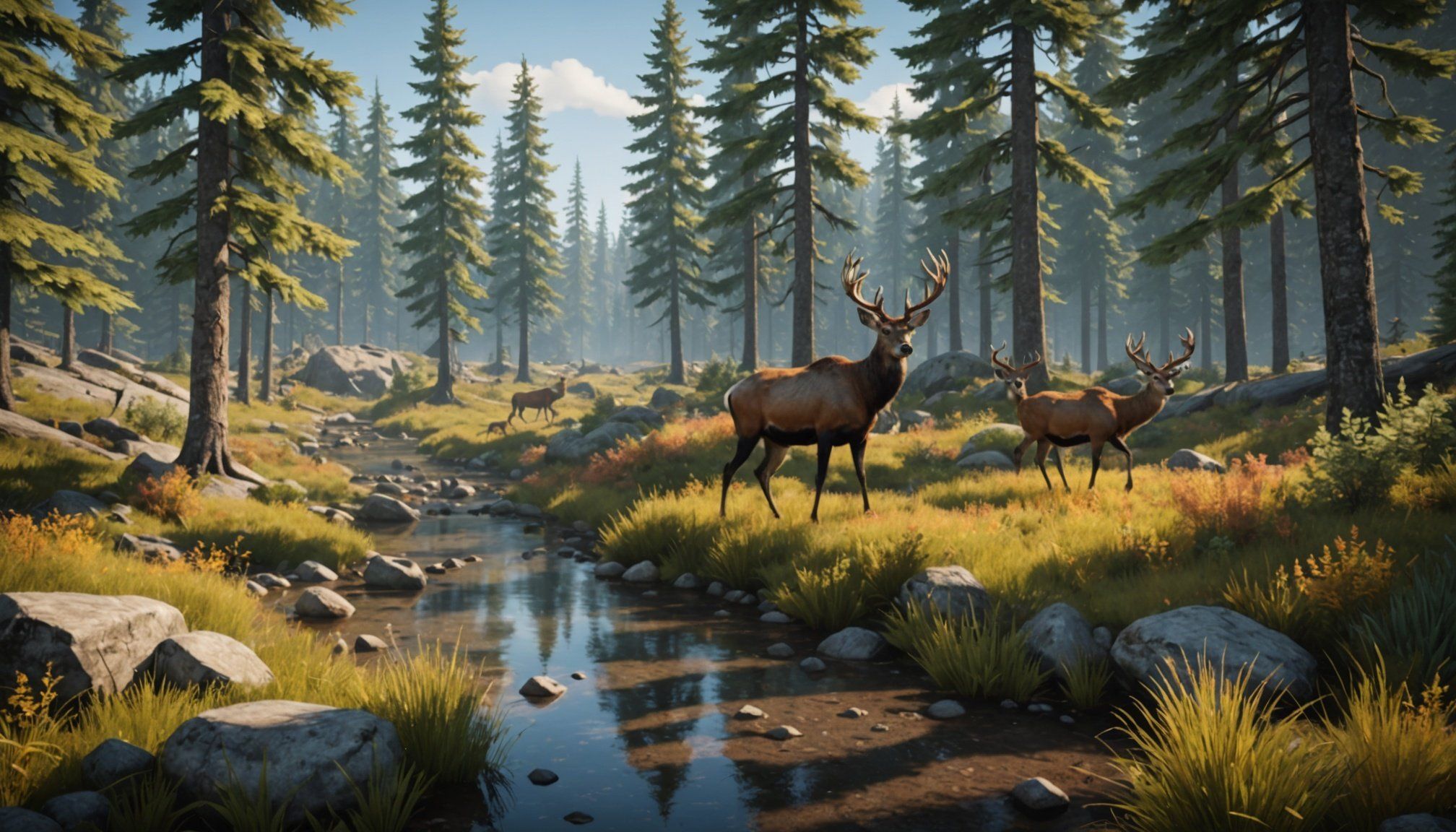Overview of Next-Gen Wildlife Simulations
Next-Gen Wildlife Simulations represent a leap in gaming technology, offering immersive gaming experiences that closely mimic real-world ecosystems. These simulations are designed to engage players by accurately recreating the intricacies of nature, from animal behaviour to environmental dynamics. The core significance of these simulations lies in their ability to provide educational and entertainment value through realistic portrayals of wildlife.
The evolution of simulation games has been driven by technological advancements, enabling more sophisticated and lifelike representation within these digital ecosystems. Initially, wildlife games were simplistic, focusing more on basic gameplay rather than realism. However, the advent of enhanced computing power, graphics, and AI technology has transformed this niche into richly detailed virtual worlds.
Have you seen this : Unleashing AI Creativity: Crafting Unique Roguelike Game Levels with Procedural Innovations
Immersive gaming experiences are pivotal in elevating the player’s engagement level. These experiences are crafted through high-quality visuals, sound design, and interactive elements, creating a sense of presence within the game. By simulating realistic interactions and environments, players can experience wildlife as both observers and participants. This level of immersion not only captivates the interest of casual gamers but also caters to enthusiasts and professionals keen on exploring wildlife dynamics, reinforcing the importance of such simulations beyond mere entertainment.
The Role of Real-Time Biome Data
Real-time biome data is revolutionizing wildlife simulations, creating ever-evolving and dynamic environments. This data ensures that the virtual ecosystems in Next-Gen Wildlife Simulations reflect current real-world conditions, like weather changes or seasonal shifts. By utilizing actual environmental data, these simulations deliver enhanced gameplay experiences that are responsive and ever-changing, providing players with a unique encounter each time they play.
Also to discover : Revolutionizing Action Gaming: The Impact of Real-Time Physics on Combat Realism
The incorporation of biome data into gaming is more than just a technical exercise—it transforms the immersive qualities of these games. As players navigate through these dynamic landscapes, they experience firsthand the impact of natural phenomena, from migrating wildlife to changing weather patterns. This promotes a deeper understanding of ecological systems and heightens player engagement.
Several games have set themselves apart by effectively integrating real-time biome data. For instance, titles like “Planet Zoo” and “Ecosystem” have employed this technology to drive their interactive worlds. These case studies underscore how accurate data incorporation can enhance realism and player immersion, proving how essential real-time biome data is for crafting authentic simulation experiences. By advancing these technologies, wildlife simulations continue to evolve, merging educational value with captivating gaming adventures.
Comparison of Existing Wildlife Simulation Games
Exploring the diverse world of wildlife simulation games reveals striking differences. Each title offers unique immersive aspects that cater to various player interests. Games like “Ecosystem” and “Planet Zoo” stand out for their commitment to realism. They use advanced technologies to create detailed habitats and behaviors, allowing players to engage closely with natural phenomena. These games draw players into engaging ecosystems where they can observe and interact as part of the environment.
Immersive Aspects of Popular Titles
In titles like “Planet Zoo” and “Ecosystem,” immersive gaming experiences are integral. Players get to shape ecosystems, manage wildlife behavior, and maintain realistic habitats. Such immersive features are highly praised by casual players and wildlife enthusiasts alike.
Gameplay Mechanics and Features
Game mechanics vary significantly between titles. Features like real-time weather patterns or dynamic animal behaviors elevate the gameplay mechanics. “Planet Zoo” excels in offering complex systems for animal care and park management, while “Ecosystem” focuses on the evolution of life forms in a digital landscape, using physics and real-time biome data.
Player Engagement and Feedback
Players often express a deep sense of connection and satisfaction in these simulations. Feedback indicates growing appreciation for the educational elements and enhanced gameplay supported by community-generated content and dynamic worlds. Such engagement encourages developers to continuously refine these wildlife simulation games.
Technological Innovations in Wildlife Simulation
Technological innovations in wildlife simulations are reshaping the gaming landscape by integrating advanced solutions like AI and machine learning. These cutting-edge technologies enable simulations to portray more lifelike animal behaviours and interactions within their ecosystems. For instance, machine learning algorithms can process vast amounts of environmental data, helping create dynamic behavioural patterns that evolve with the player’s actions. This leads to an enriched user experience, as players encounter varied scenarios each time they play.
AI enhances these immersive gaming experiences by introducing intelligent non-player characters (NPCs). These NPCs react unpredictably yet realistically to environmental changes or player interventions, thus preserving the authenticity of the simulation. Additionally, technological advancements have enabled developers to push the limits of graphics and realism further, offering visually stunning worlds that captivate players.
Looking ahead, the trajectory of gaming technology suggests even more sophisticated capabilities in the future. Developers are exploring possibilities such as augmented reality (AR) and virtual reality (VR), which are poised to deepen player interaction and immersion. As these advancements continue to unfold, they promise to elevate the standards for wildlife simulation games, ensuring more detailed and authentic virtual ecosystems for players to explore.
Future Developments in Wildlife Simulations
The future of next-gen wildlife simulations holds exciting possibilities, promising to redefine gaming evolution. The integration of augmented reality (AR) and virtual reality (VR) technologies is anticipated to create more immersive and interactive experiences. By enabling players to “enter” the simulation, these platforms could revolutionise engagement, offering new dimensions in observing and interacting with wildlife.
Upcoming titles are expected to incorporate advances such as neural networks and real-time data analytics to simulate even more sophisticated ecosystems. These emerging technologies have the potential to offer adaptive AI, making in-game wildlife interactions unpredictable and lifelike. This progression means players could witness spontaneous migration patterns or ecosystem changes influenced by real-world environmental data.
Moreover, continuous improvement in gaming technology promises richer graphical fidelity, further enhancing the “realness” of these virtual environments.
Developers are increasingly recognising the educational potential of these simulations. Titles anticipated in the near future may include features that accentuate conservation awareness and real-world ecological impacts, encouraging players to appreciate biodiversity and the delicate balance of natural ecosystems. As these future developments unfold, wildlife simulations will likely become indispensable tools for both entertainment and education.
Visuals and Gameplay Mechanics
The stunning visuals in gaming significantly enhance players’ immersion within next-gen wildlife simulations. High-quality graphics breathe life into virtual ecosystems, making interactions with wildlife feel authentic. The use of detailed textures and realistic lighting sets the stage for players to deeply engage with the natural world. These elements create visually appealing landscapes that draw players into an enthralling experience.
Alongside visuals, well-crafted gameplay mechanics are crucial. These mechanics define how players interact with the game world, ensuring that actions and responses feel intuitive. For instance, realistic animal behaviours and dynamic environmental effects, such as weather systems, offer layers of depth and realism. A seamless interaction design allows players to navigate complex ecosystems with ease, maximizing engagement and providing a satisfying user experience.
Successful wildlife simulations often employ a thoughtful balance of visual grandeur and gameplay intricacy. Games like “Planet Zoo” and “Ecosystem” use intricate graphics paired with sophisticated mechanics to create captivating and educational environments. Notably, when visuals and mechanics are harmoniously integrated, the result is a game that not only entertains but also educates, immersing players in the wonders of the natural world. This synergy is integral to meaningful and unforgettable gaming experiences.
User Testimonials and Developer Insights
Diving into the world of wildlife simulations, user testimonials highlight the thrill of interacting in lifelike ecosystems—bringing players closer to nature without leaving the comfort of their couch. Many users express joy in the detailed attention to the behaviours and interrelations of wildlife, often referring to these games as both educational and immensely engaging. Players frequently describe an emotional connection to their virtual environments, contributing to a gaming experience that is both fulfilling and informative.
Insights from developer insights provide clarity on the nuances of creating these rich, immersive experiences. Developers emphasise the importance of player feedback, noting that it’s pivotal in fine-tuning mechanics and enhancing gameplay experiences to better mimic the real world’s complexity. This collaborative approach ensures that simulations remain exciting and challenging, pushing the boundaries of what players can expect.
- Community feedback is crucial in evolving game features, allowing developers to address user needs and anticipate future trends.
- The insights gained from player experiences often lead to updates that make virtual ecosystems even more dynamic and lifelike.
Together, these reflections from both players and creators underscore the ongoing evolution of wildlife simulations, shaped by a dialogue between developers and their dedicated communities.











